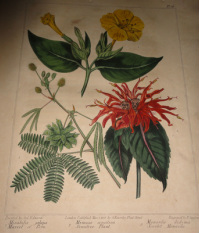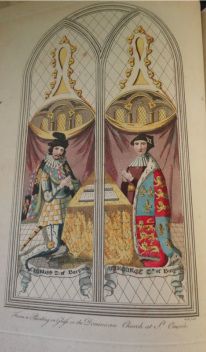The Royal Academy of Arts
|
EDWARDS, Sydenham
|
FENN, John.
|
THE TRYAL OF SIR HENRY VANE, KNIGHT. 1662
THE TRYAL OF SIR HENRY VANE, KNIGHT. AT THE KINGS BENCH, WESTMINSTER, JUNE THE 2D. AND 6TH. 1662. TOGETHER WITH WHAT HE INTENDED TO HAVE SPOKEN THE DAY OF HIS SENTENCE (JUNE 11.) FOR ARREST OF JUDGMENT, (HAD HE NOT BEEN INTERRUPTED AND OVER-RULED BY THE COURT) AND HIS BILL OF EXCEPTIONS. WITH OTHER OCCASIONAL SPEECHES, &c. ALSO HIS SPEECH AND PRAYER, &c. ON THE SCAFFOLD
London printing of 1662;- 135 pages with a poem, ‘on the sufferings of the renowned Sir H. Vane, Knight.’ to the last page 134 and on page 135 ‘ the printer to the reader’ errata leaf. The book starts on page 5, THE TRYAL OF SIR HENRY VANE, KT. AT THE KINGS BENCH, WESTMINSTER, JUNE THE 2D. AND 6TH. 1662. ;- Reader;- otherwise a scarce/rare book. Brown leather spine, with faded marbled paper to the covers. Page 48 censored on six lines with old ink scribble out, the same on page 55, but also hand-written notes in old ink. ex-libro of New College, London on ink stamps. 1st. Edition and the only edition;- Henry Vane was born in England in 1613, came to New England in 1635, and was elected governor of Massachusetts the following year, aged only twenty-three. Deeply religious, Vane was among the most radical of Puritans. He supported Anne Hutchinson during the Antinomian crisis, and became a close ally of John Cotton. Vane's stay in Massachusetts was tempestuous, and he returned to England in 1637 to become a member of the Long Parliament, though his interest in New England continued. Vane was instrumental in procuring the Rhode Island charter, and his friendly efforts to aid the New England colonies were appreciated by Roger Winthrop and Roger Williams. Soon after the fall of Cromwell and the restoration of the monarchy he was imprisoned for two years, convicted of treason, and executed. Lowndes says "THE TRYAL was written by a Sectarist in favour of Vane and printed by stealth." The text contains the speech he had intended to speak from the scaffold (but was forbidden by court order) which would have elaborated his revolutionary ideas on parliamentary supremacy and the compact between ruler and ruled, issues that resounded in colonial American history for more than the next one hundred years. |
MILTON, JOHN (Robert Vaughan,Editor)
|
Il Don Giovanni. A Grand Romantic Opera in two acts. Arranged & Edited From his German Copy for the Piano Forte by John Barnett. Italian and German text. Vocal score.MOZART, Wolfgang AmadeusPublished in London: By Mayhew, Isaac & Co., [1835?]. National Library of Standard Music. Folio 250 pages. Original binding with green leather spine and corners, and green marbled paper. Gilt lettering and decorations along the spine. In fine condition for an early published music book of Mozart.
The opera was commissioned as a result of the overwhelming success of Mozart's trip to Prague in January and February of 1787. The subject matter may have been chosen in consideration of the long history of Don Juan operas in Prague; indeed, the genre of eighteenth-century Don Juan opera originated in Prague. Don Giovanni was originally to have been performed on 15 October 1787 for a visit to Prague of the Archduchess Maria Theresa of Austria, niece of the Emperor Joseph II, and her new husband, Prince Anthony of Saxony; however, the production could not be prepared in time and Le nozze di Figaro was substituted instead on the order of the emperor himself. The score was completed on 28 October 1787 after Da Ponte was recalled to Vienna to work on another opera. Reports about the last-minute completion of the overture conflict; some say it was completed the day before the premiere, some on the very day. More likely it was completed the day before, in light of the fact that Mozart recorded the completion of the opera on 28 October. The score calls for double woodwinds, two horns, two trumpets, three trombones (alto, tenor, bass), timpani, basso continuo for the recitatives, and the usual string section. The composer also specified occasional special musical effects. For the ballroom scene at the end of the first act, Mozart calls for two onstage ensembles to play separate dance music in synchronization with the pit orchestra, each of the three groups playing in its own meter (a 3/4 minuet, a 2/4 contradanse and a fast 3/8 peasant dance), accompanying the dancing of the principal characters. In act 2, Giovanni is seen to play the mandolin, accompanied by pizzicato strings. In the same act, two of the Commendatore's interventions ("Di rider finirai pria dell'aurora" and "Ribaldo, audace, lascia a' morti la pace") are sustained by trombones and bassoons, albeit this moment occurs during a recitativo secco. The opera was first performed on 29 October 1787 in Prague under its full title of Il Dissoluto Punito ossia il Don Giovanni – Dramma giocoso in due atti (The Rake punished, or Don Giovanni, a dramma giocoso in two acts). The work was rapturously received, as was often true of Mozart's work in Prague, (See Mozart and Prague). The Prager Oberpostamtzeitung reported, "Connoisseurs and musicians say that Prague has never heard the like," and "the opera ... is extremely difficult to perform."[5] Provincialnachrichten of Vienna reported, "Herr Mozart conducted in person and was welcomed joyously and jubilantly by the numerous gathering. Mozart also supervised the Vienna premiere of the work, which took place on 7 May 1788. For this production, he wrote two new arias with corresponding recitatives – Don Ottavio's aria "Dalla sua pace" (K. 540a, composed on April 24 for the tenor Francesco Morella), Elvira's aria "In quali eccessi ... Mi tradì quell'alma ingrata" (K. 540c, composed on April 30 for the soprano Caterina Cavalieri)[7] – and the duet between Leporello and Zerlina "Per queste tue manine" |
































